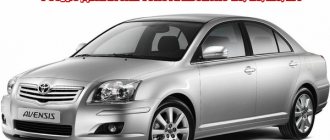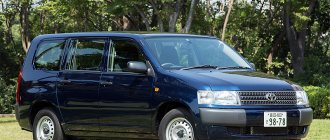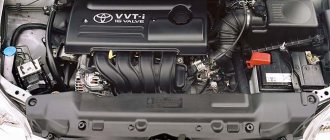Specifications
| Country of Origin | Japan |
| Performance characteristics | |
| Maximum speed | 180 km/h |
| Acceleration time | 12.5 s |
| Tank capacity | 50 l. |
| Fuel consumption: | 5.8 /100 km |
| Recommended fuel | AI-92, AI-95 |
| Engine | |
| Type | Petrol L4 |
| Number of cylinders | 4 |
| Number of valves per cylinder | 4 |
| Working volume | 1496 cm3 |
| Intake type | Injector, distributed fuel injection |
| Maximum power | 110 hp at 6000 rpm |
| Maximum torque | 141 N*m at 4400 rpm |
| Body | |
| Number of seats | 5 |
| Length | 4175 mm |
| Width | 1695 mm |
| Height | 1470 mm |
| Trunk volume | 450 l |
| Wheelbase | 2600 mm |
| Ground clearance | 160 mm |
| Curb weight | 1090 kg |
| Full mass | 1375 kg |
| Transmission | |
| Transmission | Automatic transmission |
| Number of gears | 4 |
| Drive unit | Front |
| Steering | |
| Amplifier type | Hydraulic |
Japanese hatchback interior
Engine 3zz Toyota Corolla reviews.
toyota corolla (e120) We can say that the Toyota Corolla Runx was one of the first Japanese hatchbacks. The designers did a great job, so the luggage compartment and interior turned out to be the real pride of the Toyota Corolla. The specialists managed to think through the smallest details, which made the choice of many drivers clear. What are the important subtleties of a family car?
- Seating arrangement;
- Ergonomic dashboard;
- Inexpensive finishing.
Perhaps the technical specifications are of most interest to experienced motorists. It’s worth stepping away from them a little, since the Corolla Runx first offers you to get acquainted with the interior details. Moreover, each of them must be considered in detail in order to understand the reasons for the choice of designers.
Seat arrangement
The available interior space in the traditional Toyota Corolla is divided in favor of the driver and front passenger. A couple of people could hardly fit in the back seat, which was a clear disadvantage of the sedan. The Runx hatchback turned out to be a real mirror image of its predecessor.
In the Runx model, the main emphasis is placed on the rear seats, which was achieved solely due to the five-door body structure. Now three adults can fit here. Because of this, the updated Toyota Corolla has become an ideal choice for a large family. Moreover, the driver has enough space for comfortable trips.
Ergonomic dashboard
Surely the technical characteristics will surprise motorists who have had time to get acquainted with the dashboard. From this point of view, the Runx hatchback is superior to many competitors. The specialists of the Japanese concern chose to include a large list of useful electronics in the basic package. So in the updated Toyota Corolla you will immediately have to get used to the mass of switches.
It would seem that the various equipment should be a little scary for inexperienced motorists, but in Runx the location of each individual element is thought out. This demonstrates ergonomics, allowing the driver to freely reach any switch. This fact also suggests that technical characteristics are not the main nuance.
Inexpensive finishing
The modified Toyota Corolla impressed buyers with its thoughtful interior, but the finishing was no less surprising. It is made of inexpensive plastic and leather substitute. In this, Runx is inferior to its European competitors. Although experienced drivers will quickly understand why the designers made this choice.
Due to this, the Toyota Corolla hatchback has remained an inexpensive Japanese car, which is why the model is chosen by many families. Even if the technical indicators are a little disappointing, we manage to get a wonderful family car.
Toyota Corolla Runx History
A car called Toyota Corolla Runx can be classified as a high-quality European hatchback.
The model was produced by the popular Japanese automaker Toyota and belonged to the Corolla family. It was this model that gave birth to many other cars of this famous Japanese brand. Note that the Toyota Corolla Ranx also has a twin brother. This is a Toyota Allex model. The configurations and design of the cars are almost completely identical. The only minor differences are in the exterior design: the Allex has some chrome elements, and the Runx is painted in body color. In all other respects, these hatchbacks are completely identical. The reason for the decision to produce two identical cars under different names was that they were sold by two different dealers.
So, the first generation of this hatchback rolled off the production lines for the first time in 2001. When creating these cars, designers and engineers were guided by the desire to create a premium European hatchback with 5 doors. It is noteworthy that in appearance the car is very similar to a traditional sedan. What makes it a hatchback is the slightly rough cut rear section of the trunk. To brighten up this design feature, the designers decided to install larger lights.
Externally, the Toyota Allex had a retro-style appearance, but the RunX boasted a sportier appearance. The engine lineup was absolutely the same for both models - 1.5- and 1.8-liter engines.
Each of these two models had its own names of configurations, but in terms of filling they were similar to each other. In addition, the client could select a package from additional options. The final option here was limited only by the size of the wallet and the client’s imagination. The RunX had a wider list of configurations, since the options were more variable.
In early autumn 2002, Toyota released the first generation restyling. According to management, a fresher design will contribute to better sales and popularization of the hatchback. During the restyling, the design and shape of the headlights, bumper and some other elements changed.
In the spring of 2004, the second restyling of the first generation Toyota Runx appeared on the market. The exterior and interior design has been improved. Added new color schemes for the hatchback. By refreshing the design, the company tried to increase sales of the car again. They succeeded. The hatchback remained on the market until the fall of 2009.
Exterior and interior of a Japanese hatchback
It seemed, looking at the photo, that this was an ordinary sedan, but strangely chopped off at the back, and the designers, in order to smooth out the impression of this oddity, installed large rear lights, giving the car a European look. The front end of the Runx was distinguished by a radiator grille and headlight sizes that differed from the traditionally narrow headlight configuration of Japanese cars.
Some roughness of the body lines of the NZE121 emphasized the peculiarity of this car and hinted that this is a family car, and it does not need high speed, comfort and reliability are rather important to it. True, the spoiler above the rear window and the large dimensions of the rear lights give the car some sporty power, thereby delighting ambitious drivers who want to stand out from the crowd.
The Corolla Ranx is one of the initial hatchbacks of the Japanese automotive industry, and we must pay tribute to the developers who thought through the design of the interior and luggage compartment to create a real family car. They carefully positioned the seats, made an ergonomic dashboard and used inexpensive materials for interior decoration.
The thoughtfulness of each element of the dashboard is surprising; with a large number of switches and buttons, it is convenient for the driver to reach any of them; useful electronics are located very ergonomically.
Thanks to the design features of the five-door body, it was possible to increase the space to comfortably fit three people on the back seat of the hatchback, which is not typical for a traditional Toyota Corolla. Finishing from inexpensive plastic and leatherette has made the hatchback a truly budget car, so it is not surprising that it is chosen as a family car.
In 2002, after modification, the design of the bumpers was improved, and the headlights received a new shape. In 2004, manufacturers once again tried to refresh the appearance and interior of the car by making another facelift. But the changes made allowed the 2003 Toyota Ranx to exist. only until the end of autumn 2009.
Options
This hatchback is equipped with 1.5- and 1.8-liter engines that run on gasoline. The designers decided to offer the client only one type of transmission - a 4-speed automatic. This is a traditional gearbox for many models of the brand. Only for the sports version was a 6-speed manual transmission.
The performance of power units varies from 105 to 190 hp. The traditional drive for this hatchback is front-wheel drive, but Toyota also offered all-wheel drive versions of the Toyota Ranx to its customers.
The basic package included air conditioning, central locking, steering column with angle adjustment, glass with UV protection and much more. As additional options, the client could order PTF, DVD, a 6-speaker audio system, navigation and tinted windows.
Oil for Toyota Ranx
One of the important factors in the long-term operation of the engine is the quality of the oil that is poured into it. Of course, it is better to use original oil, but it is not available everywhere.
Toyota brand oil ensures the formation of a thin but durable film on all rubbing components, facilitating easy sliding of parts and preventing the formation of scuffing and jamming of engine elements.
This oil prevents the engine from overheating and removes heat well. With its help, microscopic gaps in the cylinder group are closed, providing high compression. Detergent additives clean parts and remove deposits that form when the engine overheats.
Choose oil from other manufacturers according to API classification no lower than 10W30, but for engines with a VVTi system 5W20 or 5W30 is better suited. It is recommended to change Toyota brand products in winter after a mileage of 4–4.5 thousand km, in summer – after 5 thousand kilometers.
Body design
The Toyota Corolla Runx is a typical hatchback. This is how some drivers describe the model. If you take a closer look at the body, you will be able to identify several striking details. Perhaps, it was they who gave the Corolla Runx fame, because the Toyota Corporation until its introduction was considered a recognized manufacturer of budget models.
First of all, the front part is important. The Runx intrigued many with its custom grille and elongated headlights. The traditional Toyota Corolla was a sedan, so motorists did not expect any surprises. Large elongated lights resembled popular European cars, surprising buyers.
In addition, the shape of the Toyota Ranx is far from standard. No elongated lines, rather a rough body. Yes, the designers did not try to give the hatchback increased speed qualities. They just wanted to create a truly family car, and the Corolla Runx became one.
True, the small spoiler and rear lights are pleasing. They give the Ranx power while hiding average specs. Even demanding drivers are happy to get behind the wheel, knowing that they can stand out from the crowd. Because of this, the hatchback gained fame at one time.
Design
The Toyota Corolla Ranx is a typical hatchback, which, thanks to several pronounced body parts, stands out among the crowd of similar cars. The front of the car is distinguished by a radiator grille and headlights, which differ from the usual lights of a Japanese car. Already at first glance, the body design of the NZE121 suggests that this is a reliable and comfortable car for the whole family. The rear spoiler, as well as large side lights, give the car a sporty look, making it stand out from the crowd on the road.
The developers carefully thought out the design of the luggage compartment and interior, placed the seats comfortably, and also made the dashboard more ergonomic, on which all the switches are located so that you can easily reach each of them, all this led to the fact that the hatchback has become an excellent car for everyone. families. The special design of the body made it possible to increase the space of the passenger compartment, as a result, three people can easily fit on the rear sofa. The interior is trimmed with inexpensive plastic and leatherette, which makes the car more budget-friendly.
The Runx model is similar to the Toyota Allex model, which differs only in a few elements on the body, but otherwise these models are identical.
In 2002, the car was modified, resulting in an improved bumper design and a change in the shape of the headlights. In 2004, the interior and appearance of the car were finalized and were produced without changes until 2009, and at the end of the autumn of the same year it ceased to be produced.










